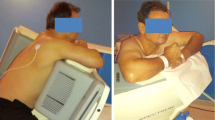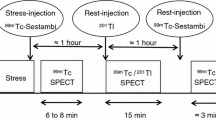Abstract
Background
In light of recent focus on diagnostic imaging, cardiac SPECT imaging needs to become a shorter test with lower radiation exposure to patients. Recently introduced Cadmium Zinc Telluride (CZT) cameras have the potential to achieve both goals.
Methods
During a 2-month period patients presenting for a Tc-99m sestamibi SPECT MPI study were imaged using a CZT camera using a low-dose rest-stress protocol (5 mCi rest and 15 mCi stress doses). Patients ≥250 lbs or a BMI ≥35 kg/m2 were excluded. Rest images were processed at 5- and 8-minute acquisition times and stress images at 3- and 5-minute acquisition times. A subset of patients had stress imaging performed using both conventional and CZT SPECT cameras. Image acquisition times and SPECT camera images were compared based on total counts, count rate, image quality, and summed rest and stress scores. Twelve month clinical follow-up was also obtained.
Results
131 patients underwent the study protocol (age 64.9 ± 9.8 years, 54.2% male). There was no significant difference in image quality and mean summed scores between 5- and 8-minute rest images and between 3- and 5-minute stress images. When compared to a conventional SPECT camera in 27 patients, total rest and stress perfusion deficits and calculated LVEF were similar (r = 0.94 and 0.96, respectively). At 12 months there was a benign prognosis in patients with normal perfusion. The effective dose was 5.8 mSv for this protocol which is 49.2% less than conventional Tc-99m studies and 75.7% less than conventional Tl-201/Tc-99m dual isotope studies.
Conclusions
New SPECT camera technology with low isotope dose significantly reduces ionizing radiation exposure and imaging times compared to traditional protocols while maintaining image quality and diagnostic accuracy.






Similar content being viewed by others
References
Einstein AJ, Moser KW, Thompson RC, Cerqueira MD, Henzlova MJ. Radiation dose to patients from cardiac diagnostic imaging. Circulation 2007;116:1290-305.
Fazel R, Krumholz HM, Wang Y, Ross JS, Chen J, Ting HH, et al. Exposure to low-dose ionizing radiation from medical imaging procedures. N Engl J Med 2009;361:849-57.
NCRP. NCRP Publications. Report No. 160—Ionizing Radiation Exposure of the Population of the United Sates (2009); 2010
Gerber TC, Gibbons RJ. Weighing the risks and benefits of cardiac imaging with ionizing radiation. JACC Cardiovasc Imaging 2010;3:528-35.
Cerqueira MD, Allman KC, Ficaro EP, Hansen CL, Nichols KJ, Thompson RC, et al. ASNC Information Statement: Recommendations for reducing radiation exposure in myocardial perfusion imaging. http://www.asnc.org/imageuploads/RadiationReduction060110.pdf; 2010
US Food and Drug Administration Center for Devices and Radiological Health: Initiative to reduce unnecessary radiation exposure from medical imaging. http://www.fda.gov/Radiation-EmittingProducts/RadiationSafety/RadiationDoseReduction/UCM199904; 2010
Chang SM, Nabi F, Xu J, Raza U, Mahmarian JJ. Normal Stress-Only Versus Standard Stress/Rest Myocardial Perfusion Imaging Similar Patient Mortality With Reduced Radiation Exposure. J Am Coll Cardiol 2010;55:221-30.
Duvall WL, Wijetunga MN, Klein TM, Razzouk L, Godbold J, Croft LB, et al. The prognosis of a normal stress-only Tc-99m myocardial perfusion imaging study. J Nucl Cardiol 2010;17:370-7.
Duvall WL, Croft LB, Godiwala T, Ginsberg ES, George T, Henzlova MJ. Reduced isotope dose with rapid SPECT MPI imaging: Initial experience with a CZT SPECT camera. J Nucl Cardiol 2010;17:1009-14.
Slomka PJ, Patton JA, Berman DS, Germano G. Advances in technical aspects of myocardial perfusion SPECT imaging. J Nucl Cardiol 2009;16:255-76.
Esteves FP, Raggi P, Folks RD, Keidar Z, Askew JW, Rispler S, et al. Novel solid-state-detector dedicated cardiac camera for fast myocardial perfusion imaging: Multicenter comparison with standard dual detector cameras. J Nucl Cardiol 2009;16:927-34.
Hansen CL, Goldstein RA, Berman DS, Churchwell KB, Cooke CD, Corbett JR, et al. Myocardial perfusion and function single photon emission computed tomography. J Nucl Cardiol 2006;13:e97-120.
Henzlova MJ, Cerqueira MD, Hansen CL, Taillefer R, Yao SS. ASNC Announcement. J Nucl Cardiol 2009;16:331.
Henzlova MJ, Cerqueira MD, Mahmarian JJ, Yao SS. Stress protocols and tracers. J Nucl Cardiol 2006;13:e80-90.
ICRP. ICRP Publication 80: Radiation dose to patients from radiopharmaceuticals (Addendum 2 to ICRP publication 53). Ann ICRP 1998;28:1-126.
ICRP. ICRP Publication 106: Radiation dose to patients from radiopharmaceuticals (Addendum 3 to ICRP publication 53). Ann ICRP 2008;38:1-197.
ICRP. ICRP Publication 103: The 2007 Recommendations of the International Commission on Radiological Protection. Ann ICRP 2007;37:1-332.
Hendel RC, Berman DS, Di Carli MF, Heidenreich PA, Henkin RE, Pellikka PA, et al. ACCF/ASNC/ACR/AHA/ASE/SCCT/SCMR/SNM 2009 appropriate use criteria for cardiac radionuclide imaging: A report of the American College of Cardiology Foundation Appropriate Use Criteria Task Force, the American Society of Nuclear Cardiology, the American College of Radiology, the American Heart Association, the American Society of Echocardiography, the Society of Cardiovascular Computed Tomography, the Society for Cardiovascular Magnetic Resonance, and the Society of Nuclear Medicine. Circulation 2009;119:e561-87.
Cerqueira MD, Weissman NJ, Dilsizian V, Jacobs AK, Kaul S, Laskey WK, et al. Standardized myocardial segmentation and nomenclature for tomographic imaging of the heart: A statement for healthcare professionals from the Cardiac Imaging Committee of the Council on Clinical Cardiology of the American Heart Association. J Nucl Cardiol 2002;9:240-5.
Sharir T, Slomka PJ, Hayes SW, DiCarli MF, Ziffer JA, Martin WH, et al. Multicenter trial of high-speed versus conventional single-photon emission computed tomography imaging: Quantitative results of myocardial perfusion and left ventricular function. J Am Coll Cardiol 2010;55:1965-74.
Herzog BA, Buechel RR, Katz R, Brueckner M, Husmann L, Burger IA, et al. Nuclear myocardial perfusion imaging with a cadmium-zinc-telluride detector technique: Optimized protocol for scan time reduction. J Nucl Med 2010;51:46-51.
Sharir T, Ben-Haim S, Merzon K, Prochorov V, Dickman D, Berman DS. High-speed myocardial perfusion imaging initial clinical comparison with conventional dual detector anger camera imaging. JACC Cardiovasc Imaging 2008;1:156-63.
Berman DS, Kang X, Tamarappoo B, Wolak A, Hayes SW, Nakazato R, et al. Stress thallium-201/rest technetium-99 m sequential dual isotope high-speed myocardial perfusion imaging. JACC Cardiovasc Imaging 2009;2:273-82.
Buechel RR, Herzog BA, Husmann L, Burger IA, Pazhenkottil AP, Treyer V, et al. Ultrafast nuclear myocardial perfusion imaging on a new gamma camera with semiconductor detector technique: First clinical validation. Eur J Nucl Med Mol Imaging 2010;37:773-8.
Ben-Haim S, Kacperski K, Hain S, Van Gramberg D, Hutton BF, Erlandsson K, et al. Simultaneous dual-radionuclide myocardial perfusion imaging with a solid-state dedicated cardiac camera. Eur J Nucl Med Mol Imaging 2010;37:1710-21.
Shaw LJ, Iskandrian AE. Prognostic value of gated myocardial perfusion SPECT. J Nucl Cardiol 2004;11:171-85.
Hachamovitch R, Hayes S, Friedman JD, Cohen I, Shaw LJ, Germano G, et al. Determinants of risk and its temporal variation in patients with normal stress myocardial perfusion scans: What is the warranty period of a normal scan? J Am Coll Cardiol 2003;41:1329-40.
Garcia EV, Tsukerman L, Keidar Z. A new solid state, ultra fast cardiac multi-detector SPECT system (Abstract). J Nucl Cardiol 2008;15:S3.
Herzog BA, Husmann L, Buechel RR, Pazhenkottil AP, Burger IA, Valenta I, et al. Rapid cardiac hybrid imaging with minimized radiation dose for accurate non-invasive assessment of ischemic coronary artery disease. Int J Cardiol 2010; Sept 6 (Epub ahead of print).
Herzog BA, Husmann L, Landmesser U, Kaufmann PA. Low-dose computed tomography coronary angiography and myocardial perfusion imaging: Cardiac hybrid imaging below 3 mSv. Eur Heart J 2009;30:644.
Author information
Authors and Affiliations
Corresponding author
Rights and permissions
About this article
Cite this article
Duvall, W.L., Croft, L.B., Ginsberg, E.S. et al. Reduced isotope dose and imaging time with a high-efficiency CZT SPECT camera. J. Nucl. Cardiol. 18, 847–857 (2011). https://doi.org/10.1007/s12350-011-9379-7
Received:
Accepted:
Published:
Issue Date:
DOI: https://doi.org/10.1007/s12350-011-9379-7




